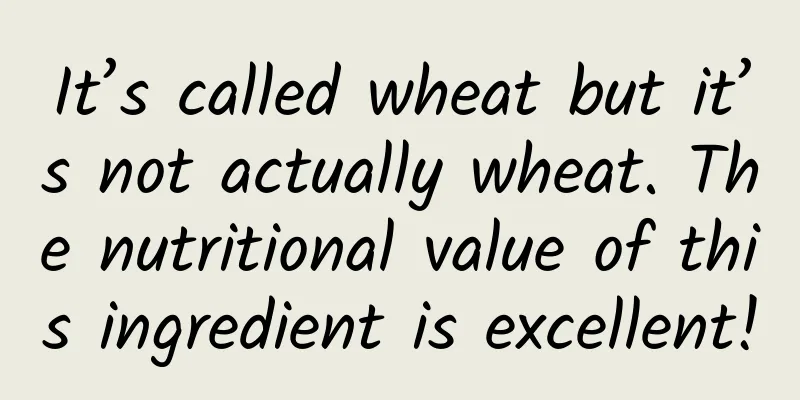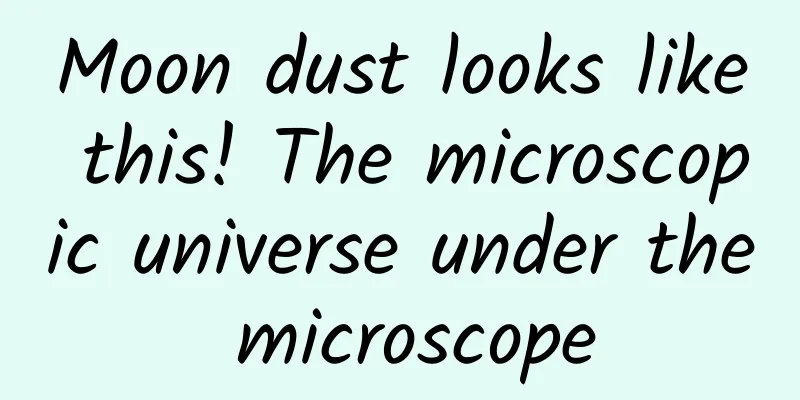It’s called wheat but it’s not actually wheat. The nutritional value of this ingredient is excellent!

|
If you have experience in losing weight or exercising, then there is a food that you are more or less familiar with, that is quinoa. In light meals or salads, quinoa usually appears as a staple food. What are its characteristics and nutritional advantages? After reading this article, I believe many friends will put quinoa on the table. Copyright images in the gallery. Reprinting and using them may lead to copyright disputes. The identity and status of quinoa Quinoa, also known as quinoa, quinoa, etc., is an annual plant with a long history, native to the Andes Mountains in South America, and is the traditional staple food of the Indians. There are more than 3,000 varieties of quinoa in the world, the most common of which are white, red and black. 1 It's called quinoa but it's not wheat From the perspective of plant classification, quinoa belongs to the Amaranthaceae family, the same family as common vegetables such as spinach and beets. The main cereals we eat every day, such as wheat and rice, all belong to the Gramineae family, so quinoa is not a cereal, but it is often eaten as a staple food. However, in order to facilitate promotion, people often classify quinoa as a cereal. Image source: self-made by the author 2 It has an absolute international status in staple food Quinoa is one of the most internationally recognized staple foods. Why? So far, only five foods have been designated as international years by the United Nations, and 2013 is the International Quinoa Day. 2004 – International Year of Rice 2008 – International Year of the Potato 2013 – International Year of Quinoa 2016 – International Year of Pulses 2023 - International Year of Xiaomi The reason why quinoa is highly praised is that in addition to its excellent nutrition, it has a particularly rich genetic diversity and can adapt well to any agricultural environment . Moreover, quinoa has a strong adaptability to global climate change and has helped many countries that lack food solve major problems. It not only increases the production of high-quality food, but also makes us less dependent on traditional staple foods such as wheat and rice. Now, quinoa has become popular in more than 70 countries around the world, from Europe to America, to Asia and Africa, and it can be seen everywhere. Quinoa was introduced to my country in the 1980s and successfully planted in Tibet and other places. After that, the scale of quinoa cultivation in my country gradually expanded. It has now been successfully introduced in Jilin, Gansu, Shanxi, Qinghai, Henan and other places, and has begun large-scale cultivation. Especially in Gansu, Qinghai, Shanxi and other regions, quinoa has been listed as a local specialty industry and an important agricultural pillar industry. Nutritional Value of Quinoa In my country, quinoa is a "new internet celebrity" with a rapid development momentum. In 2017, the Chinese Nutrition Society spent five months selecting the top ten "Chinese Good Grains", and quinoa was on the list. Why was quinoa selected as "China's Best Cereal"? This is closely related to the nutritional value of quinoa. 1 High quality and high quantity of protein The protein content of most grains is between 7g and 12g per 100g, while the protein content of quinoa is as high as 14.1g/100g, which is higher than eggs (13.1g/100g). In addition to its high content, quinoa protein is of better quality and easier to digest and absorb than most grains. This is because the lysine content of grains is generally low, which becomes a shortcoming that limits protein digestion and absorption, so it is not a high-quality protein. The lysine content in quinoa is high, with 760mg of lysine per 100g, while the general content of grains is 100mg/100g~500mg/100g. 2 High dietary fiber Quinoa has a high dietary fiber content, even higher than oats. Every 100g contains 12g~14.4g of insoluble fiber and 1.4g~1.6g of soluble dietary fiber , which helps promote digestion and prevent constipation. So although quinoa is not low in calories, it has a strong sense of fullness due to its high protein and fiber content, which is good for weight control. However, because of its high dietary fiber content, eating too much can easily cause bloating and gas . Therefore, although quinoa is good, it is recommended to only replace part of the grains and not to eat only quinoa as a staple food. As the Food and Agriculture Organization (FAO) said: "Although quinoa is rich in many nutrients, it is important to eat it as part of a balanced diet and with other foods to obtain comprehensive nutrition." 3 Low GI, blood sugar friendly When people who are losing weight or have diabetes eat staple foods, they are most afraid of blood sugar problems. Foods with a high glycemic index (GI>70) can cause blood sugar to go through a roller coaster after eating, and most staple foods are of this type. Quinoa has a very low GI of only 53, which is a low GI food. This is an ideal ingredient among staple foods. In addition to the slow rate of blood sugar rise, quinoa's carbohydrate content (58%) is also lower than other staple foods (70%~80%), so its glycemic load (GL) is better, which further widens the gap with other staple foods. 3 Super high in minerals Compared to other grains, quinoa is an excellent student in terms of minerals. Especially calcium, iron, potassium, magnesium, and zinc, which are higher than those foods we usually think are rich. For example, data from the Food and Agriculture Organization of the United Nations shows that the calcium content of quinoa is as high as 148.7mg/100g, which is 1.4 times that of milk; iron is 13.2mg/100g, which is 5.7 times that of lean beef. (The data in the "Chinese Food Composition Table" is lower, but still higher than most staple foods) But then again, quinoa, like other plants, has a small flaw, that is, it also contains some substances that affect the absorption of minerals, saponin is a representative . It hides in the quinoa seed skin, but fortunately it is scraped off during processing, otherwise it will taste bitter. There is also oxalic acid, which always likes to stick to minerals such as calcium and magnesium, making them difficult for the body to absorb. The vitamin content of quinoa is not as impressive as other nutrients, but it is still good overall, especially folic acid. Most cereals have a folic acid content of less than 50μg/100g, while quinoa is one of the few staple foods with a folic acid content of over 100, and some varieties even exceed 200μg/100g. Source: "Chinese Food Composition Table (Standard Edition/Volume 2)" Quinoa of different colors What are the differences? Quinoa is mainly divided into three types according to its color: white, red and black. They have their own characteristics in appearance, taste and nutritional value. Image source: Whole Grains Association White quinoa is lighter in color, relatively soft and sticky in texture, and has a light taste. After being boiled, it becomes fluffier than quinoa of other colors and is easier to digest. It is suitable for most people, especially those with sensitive stomachs. Red quinoa contains more fat and most alkaloids than black and white quinoa, respectively. It is brown when cooked and has a richer, slightly chewy texture, a richer taste and a stronger nuttiness. Because it holds its shape better during cooking, it is often used as a light meal or in salads. Black quinoa is dark in color, crispy in taste, and sweeter. It is rich in crude fiber, polyphenols, and flavonoids, which have antioxidant and anti-aging effects. However, because it is relatively hard and a bit irritating to the throat, it may cause bloating in people with gastrointestinal discomfort. Different colors of quinoa have their own advantages in taste and nutritional value. You can decide which color of quinoa to choose according to your personal taste preferences and nutritional needs. No matter which one you choose, quinoa is a nutritious and recommended grain. How to eat quinoa? After exploring the wonderful world of quinoa, are you eager to taste its deliciousness? Don't worry, we will introduce you to several simple and nutritious quinoa cooking methods in detail. 1 Quinoa porridge Mix quinoa with millet, rice or brown rice, wash with clean water and put into the pot. Add appropriate amount of water (usually 2-3 times the amount of quinoa), bring to a boil over high heat, then simmer over low heat, stirring from time to time to prevent sticking. For friends who like a richer taste, you can also add diced lean meat, diced carrots, diced celery and other ingredients to stew together to make delicious dishes such as quinoa chicken porridge. 2 Quinoa Rice Mix quinoa with rice or cook it alone, rinse it with clean water, and put it in the rice cooker. Add an appropriate amount of water (usually a little more than the water you normally use to cook rice), and cook it according to the normal cooking procedure. The steamed quinoa rice can not only be eaten directly, but also used for stir-frying or with other dishes, and can even be rolled up with sushi seaweed to make quinoa sushi. 3 Quinoa Salad Wash the quinoa with clean water, put it in a pot and add appropriate amount of water to cook. Drain the water and let it cool for later use. Boil or roast the chicken breast and tear it into strips. Wash and cut vegetables such as broccoli, carrots, and cherry tomatoes. Mix all the ingredients together, add vinaigrette and other seasonings, mix well and enjoy. 4 Quinoa Pastry Mix quinoa powder with flour (the ratio can be adjusted according to personal preference), add appropriate amount of water and knead into dough. Then make noodles, steamed buns or cakes according to the usual method. All of the above methods are simple and practical. You can adjust and innovate according to your taste and preferences. Remember to pay attention to the heat and stir during the cooking process to avoid sticking to the pan or the bottom. Enjoy the deliciousness and health brought by quinoa! References [1] Chinese Nutrition Society. Top Ten Best Grains—No. 10 Quinoa. https://www.cnsoc.org/knowledge/8217012054.html [2] Food and Agriculture Organization of the United Nations. Quinoa. https://www.fao.org/quinoa/en/ [3] Food and Agriculture Organization of the United Nations. What is quinoa? Nutritional value. https://www.fao.org/quinoa-2013/what-is-quinoa/nutritional-value/en/?no_mobile=1 [4] Yang Yuexin. Chinese Food Composition Table 6th Edition Volume 1[M]. Peking University Medical Press, 2018 [5]Guangtao Qian, Xiangyu Li, Heng Zhang, Hailong Zhang, Jingwen Zhou, Xiaohui Ma, Wei Sun, Wei Yang, Ruikun He, Atia-tul Wahab, Huihua Wan, Lixin Li,Metabolomics analysis reveals the accumulation patterns of flavonoids and phenolic acids in quinoa (Chenopodium quinoa Willd.) grains of different colors, Food Chemistry: Planning and production Author: Li Chun, a registered nutritionist in China Review | Ruan Guangfeng, Deputy Director of Kexin Food and Health Information Exchange Center Wang Kang, Director of the Science Museum of the National Botanical Garden Planning丨Zhong Yanping Editor: Zhong Yanping Proofread by Xu Lailinlin The cover image and the images in this article are from the copyright library Reprinting may lead to copyright disputes |
<<: Why has loratadine become a "life-saving drug" for people with allergies?
>>: The inspiration for the "underground dragon" shield machine actually comes from a mollusk
Recommend
Luo Yonghao, the founder of Smartisan: "Slapping people in the face" is part of my job
"I particularly dislike the practice of some...
A complete guide to mobile DSP advertising in 10 major industries!
More and more industries are beginning to enter t...
The entire process of a new APP from establishment to acquiring users!
In the early stages of entrepreneurship , from bu...
Today in Science and Technology History | The world's deepest known ocean blue hole is in Sansha, my country
Ocean blue holes are rare natural geographical ph...
Xiaopeng Motors G3 will be launched this spring, and the OEM is finally not JAC
Nowadays, the decline of subsidies for new energy...
How to write a public relations event plan? You need to grasp these 11 points
With the development of the market economy, publi...
An introduction to Wandoujia Mobile Assistant’s advertising styles, promotion costs and advantages!
Wandoujia is a mobile phone assistant designed sp...
New home appliance subsidies will begin, and many home appliance giants are not welcoming
With the withdrawal of the "Energy-Saving Pr...
How many ants are there on Earth? Scientists have finally counted them!
Ants are a common insect, but how many ants are t...
Mosquitoes: “Little Devil” or “Unsung Hero” in the Ecosystem?
Author: Huang Yanhong Duan Yuechu In our lives, m...
Can blood type determine life span? Who would have thought that the most powerful blood type is…
The discussion about blood type has never stopped...
Can plants get cancer?
Can plants also get cancer? Today, let’s follow t...
【Creative Cultivation Program】Why do hard drives need to be partitioned?
Author: Zhou Lei Reviewer: Chen Xudong I believe ...
Why do we care about extinction?
"Why does mass extinction occur?" is a ...
Review of the operation of Xiaohongshu’s popular community!
I had nothing to do during the recent epidemic, s...









